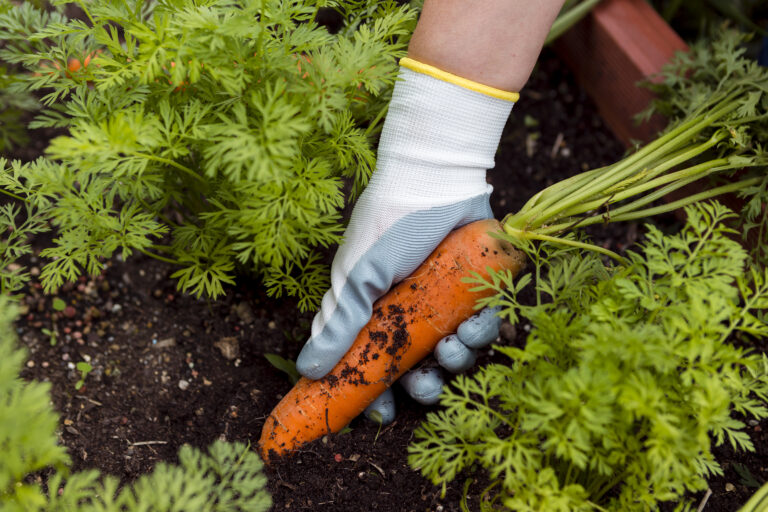How I Finally Stopped Chickens from Ruining My Garden Beds
To keep chickens out of your garden, install a chicken wire fence around your plants, which is a physical barrier they cannot easily get over or through.
You can also use a raised bed covered with netting, or place decorative ornaments and a layer of gravel or rocks around plants to deter digging.
For a less physical approach, use natural deterrents such as strong-smelling herbs, or sprinkle pungent spices like cinnamon or cayenne pepper on the ground near plants
I love keeping chickens for fresh eggs, but I quickly realized that my garden became their personal playground. Chickens are naturally drawn to garden spaces.
They love hunting for bugs, turning over soft soil, and pecking at tender greens and fruits. While they can be entertaining to watch, their curiosity can quickly turn destructive.
They scratch up soil, uproot seedlings, scatter mulch, and use soft garden beds for dust baths.
Over time, I learned that the key is to protect your plants while keeping chickens safe and stress-free. Humane strategies work best, allowing you to enjoy both healthy garden beds and happy chickens.
Table of Contents
Toggle2. Understanding Chicken Behavior
Before trying to deter chickens, it helps to understand their instincts. Chickens scratch and peck constantly as part of their foraging behavior. This instinct drives them to dig in soil, which can be devastating for young seedlings.
Chickens also love dust-bathing. They roll in loose soil to clean their feathers and control parasites. Unfortunately, this often happens in garden beds or soft mulch areas.
Finally, chickens are naturally attracted to tender greens, fruits, and vegetables. I noticed that even if I provided them with plenty of feed, they still couldn’t resist fresh salad leaves or strawberries. Understanding these behaviors helped me design humane solutions that satisfied their instincts without harming my plants
3. Physical Barriers
After watching my chickens turn over every patch of soil in my garden, I realized that physical barriers are the most reliable solution. Installing chicken-proof fencing made the biggest difference. I chose a fence about four feet high with a base buried six inches underground to prevent my chickens from digging under. This simple step stopped most of the accidental destruction while still allowing them to roam safely in their designated areas.
For raised beds, I use netting or mesh covers. These covers let sunlight and rain through while keeping chickens from scratching the soil or pecking at seedlings. For particularly vulnerable plants, I invested in row covers and small hoop houses. These lightweight structures protect young greens and delicate seedlings until they are strong enough to withstand minor chicken curiosity.
Another trick that worked well for me was building chicken wire domes over individual seedlings. These domes are inexpensive, easy to move, and provide excellent protection. They let the plants grow without interference and give me peace of mind, knowing my efforts won’t be undone overnight. Over time, I learned to combine these approaches depending on the type of plants and their location in the garden.
4. Garden Layout Strategies
Redesigning the layout of my garden was equally important. I created a separate chicken run to give them a dedicated space to scratch, forage, and dust-bathe. By keeping the garden zone off-limits, I could protect sensitive plants while still allowing my chickens to explore freely.
I also started experimenting with rotational access. I sectioned off parts of the garden and let the chickens into a designated area for limited periods. This approach keeps the soil healthy and prevents over-foraging in any one spot. Over time, my chickens learned where they could roam safely, and my garden showed much less damage.
Another strategy I found invaluable is using chicken tractors—mobile coops that allow chickens to forage on fresh ground without entering the main garden beds. I move the tractors daily, which gives the chickens new areas to explore and fertilize naturally while keeping the garden protected.
Combining physical barriers with smart garden layout strategies has transformed how I manage my backyard. I can maintain lush, productive garden beds while keeping my chickens happy and healthy. By observing their behavior and adjusting the setup over time, I discovered a balance that works for both my plants and my pets
I quickly learned that the choice of mulch and plants can make a big difference in keeping chickens out of the garden. Chickens love soft, loose soil, so I switched to prickly or tough mulches. Pinecones, small rocks, and straw bales worked wonders. Not only did they discourage scratching, but they also added texture and visual interest to my garden beds.
Plant selection also helps. I planted chicken-deterring herbs and flowers along the garden borders. Marigolds, lavender, and mint proved particularly effective. The scent keeps chickens cautious, and the dense growth reduces bare soil areas, which they naturally seek out for foraging. Over time, these deterrent plants became a natural barrier, creating a defined edge between the garden and the chicken run.
Dense planting itself can act as a deterrent. By minimizing exposed soil and spreading out mulch and plants strategically, I reduced the areas that chickens find tempting. Young seedlings now get a better chance to establish without constant disturbance.
6. Behavioral Training and Alternatives
Beyond physical and plant-based deterrents, I found that guiding chicken behavior helps maintain a harmonious garden. One of the most effective strategies is providing a designated dust-bath area away from garden beds. I set up a shallow box filled with loose sand and soil. My chickens quickly adopted it, and garden soil remained largely undisturbed.
Feeding chickens well outside the garden also helps. I make sure they have plenty of feed, fresh greens, and insects in their run. Satisfying their nutritional needs reduces their temptation to raid my vegetable beds.
Another approach I discovered is creating a “sacrifice zone.” I let chickens explore a compost pile or a wild patch of yard vegetation. This gives them a safe place to scratch, forage, and play without damaging my main garden beds. Over time, they recognize these areas as their primary activity zones and leave my plants mostly untouched.
Combining these methods mulch choices, plant barriers, and behavioral guidance—has made a noticeable difference. My garden now thrives, and my chickens remain happy, engaged, and safe. Observing their behavior and making small adjustments when needed ensures a balanced environment for both plants and poultry
7. Motion and Sensory Deterrents
I realized that adding motion and sensory elements to my garden can help steer chickens away without causing harm. Motion-activated sprinklers proved particularly effective. When chickens approached restricted areas, a short burst of water startled them just enough to discourage further exploration. I also tried motion-activated lights, which worked well in the early evening when chickens were more active.
Reflective surfaces provide another simple deterrent. I hung old CDs and strips of reflective tape around garden beds. The sunlight bouncing off these surfaces kept chickens cautious, especially when paired with other deterrents. Wind chimes or other noise-making objects also help. The gentle clinking sound alerts chickens that the area is unpredictable, which reduces their curiosity over time.
8. DIY and Creative Solutions
Not every solution has to be expensive. I discovered that repurposing materials around the house can protect my garden effectively. Old pallets, for instance, make quick fencing sections that can be moved as needed. They are sturdy enough to prevent chickens from wandering into sensitive areas and can be customized to fit any bed size.
Net curtains or mesh left over from home projects can cover raised beds or delicate seedlings. This simple solution keeps chickens out while still allowing sunlight and rain to nourish the plants. Over time, I even built raised garden beds with chicken-proof edges. By adding short fences or mesh around the perimeter, I protected young plants without limiting access for maintenance.
The key to these methods is creativity and observation. I often adjust setups based on how chickens react. Some deterrents work better in certain spots, while others lose effectiveness if left static. By combining motion-based deterrents with DIY protective measures, I maintained a healthy balance between protecting plants and letting my chickens enjoy their space safely.
FAQs: Keeping Chickens Out of the Garden
1. Can I completely stop chickens from entering the garden?
In my experience, it’s difficult to make a garden entirely off-limits without fencing. Combining multiple deterrents—physical barriers, sensory cues, and behavioral guidance—works best to minimize damage while keeping chickens safe.
2. Are motion-activated sprinklers safe for chickens?
Yes. I use them regularly, and the brief spray startles the chickens without causing harm. They learn to avoid restricted areas quickly, and I only place sprinklers in sensitive zones.
3. Which plants naturally deter chickens?
Strong-scented herbs and flowers like marigolds, lavender, and mint have worked well for me. Planted along garden edges, they reduce chicken curiosity while adding beauty and fragrance.
4. How can I protect seedlings without fencing the entire garden?
I use mesh covers, chicken wire domes, or small hoop houses over young plants. These solutions protect vulnerable seedlings while leaving other parts of the garden accessible.
5. What is a “sacrifice zone,” and does it really work?
A sacrifice zone is a designated area where chickens can scratch, forage, and dust-bathe. I set up a compost pile or wild patch in my yard, and my chickens quickly focus their energy there instead of my main garden beds.
6. Will reflective objects or wind chimes actually deter chickens?
Yes. I’ve hung old CDs and reflective tape near garden beds. Combined with gentle noises from wind chimes, they make the garden seem unpredictable, discouraging chickens from venturing too close.
7. Can I train chickens to avoid the garden?
Behavioral training works when paired with alternatives like dust-bath areas, plenty of feed, and designated foraging zones. Over time, chickens learn where they are allowed to roam.
8. How often should I check barriers and deterrents?
From my experience, weekly checks work well. I refresh scents, adjust netting, and move deterrents to prevent chickens from adapting. Small maintenance efforts keep the garden consistently protected
Conclusion
Chickens are more than just pets they are natural pest controllers, composters, and a source of fresh eggs. I learned that the goal is not to completely exclude them but to strike a balance between allowing free-ranging and protecting valuable crops.
The most effective approach I’ve found combines physical barriers with behavioral training. Fences, mesh covers, and designated dust-bath areas work alongside rotational access, sacrifice zones, and well-fed chickens to reduce garden damage. By observing behavior and adjusting strategies over time, you can maintain a thriving garden while keeping chickens happy and safe.
Finding the right combination may take some experimentation, but it creates a harmonious environment where both plants and poultry flourish. Sharing experiences with fellow gardeners can offer new ideas and practical solutions, making it easier to protect your garden while enjoying the benefits of backyard chickens.





